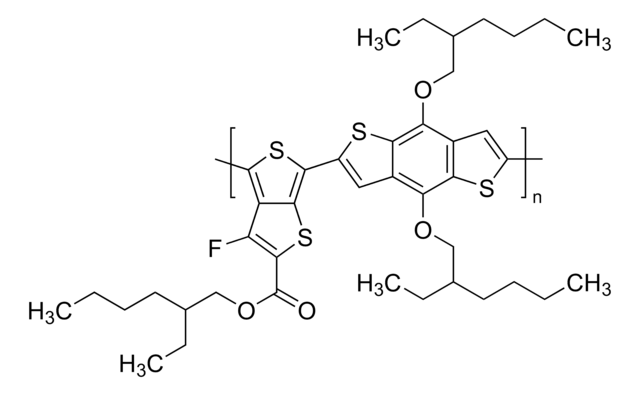If this product has an expiration or retest date, it will be shown on the Certificate of Analysis (COA, CofA). If there is no retest or expiration date listed on the product's COA, we do not have suitable stability data to determine a shelf life. For these products, the only date on the COA will be the release date; a retest, expiration, or use-by-date will not be displayed.
For all products, we recommend handling per defined conditions as printed in our product literature and website product descriptions. We recommend that products should be routinely inspected by customers to ensure they perform as expected.
For products without retest or expiration dates, our standard warranty of 1 year from the date of shipment is applicable.
For more information, please refer to the Product Dating Information document: https://www.sigmaaldrich.com/deepweb/assets/sigmaaldrich/marketing/global/documents/449/386/product-dating-information-mk.pdf
Wichtige Dokumente
702471
Poly-[bis-(4-phenyl)-(2,4,6-trimethylphenyl)-amin]
a poly(triaryl amine) semiconductor
Synonym(e):
PTAA, Poly-(triarylamin)
Größe auswählen
Größe auswählen
About This Item
Empfohlene Produkte
Qualitätsniveau
Form
solid
Mol-Gew.
average Mn 7,000-10,000 (GPC)
Grünere Alternativprodukt-Eigenschaften
Design for Energy Efficiency
Learn more about the Principles of Green Chemistry.
sustainability
Greener Alternative Product
mp (Schmelzpunkt)
>400 °C
>400 °C
Mw/Mn
2‑2.2
Anwendung(en)
battery manufacturing
semiconductor
Grünere Alternativprodukt-Kategorie
, Enabling
Halbleitereigenschaften
P-type (mobility=10−3 - 10−2 cm2/V·s)
Allgemeine Beschreibung
Lagerklassenschlüssel
11 - Combustible Solids
WGK
WGK 3
Flammpunkt (°F)
Not applicable
Flammpunkt (°C)
Not applicable
Persönliche Schutzausrüstung
Eyeshields, Gloves, type N95 (US)
Hier finden Sie alle aktuellen Versionen:
Besitzen Sie dieses Produkt bereits?
In der Dokumentenbibliothek finden Sie die Dokumentation zu den Produkten, die Sie kürzlich erworben haben.
Kunden haben sich ebenfalls angesehen
Artikel
Polytriarylamine Semiconductors
The development of high-performance conjugated organic molecules and polymers has received widespread attention in industrial and academic research.
Professor Shinar highlights low-cost, disposable sensor configurations in organic and hybrid electronics for healthcare applications.
Next generation solar cells have the potential to achieve conversion efficiencies beyond the Shockley-Queisser (S-Q) limit while also significantly lowering production costs.
-
How can I determine the shelf life / expiration / retest date of this product?
1 answer-
Helpful?
-
-
How is shipping temperature determined? And how is it related to the product storage temperature?
1 answer-
Products may be shipped at a different temperature than the recommended long-term storage temperature. If the product quality is sensitive to short-term exposure to conditions other than the recommended long-term storage, it will be shipped on wet or dry-ice. If the product quality is NOT affected by short-term exposure to conditions other than the recommended long-term storage, it will be shipped at ambient temperature. As shipping routes are configured for minimum transit times, shipping at ambient temperature helps control shipping costs for our customers. For more information, please refer to the Storage and Transport Conditions document: https://www.sigmaaldrich.com/deepweb/assets/sigmaaldrich/marketing/global/documents/316/622/storage-transport-conditions-mk.pdf
Helpful?
-
-
What is the molecular weight of PTAA with product no. 702471? and how much-optimized quality of this product is needed in one milliliter of solvent (Toluene) to coat it as a Hole transporting layer for perovskite solar cells. share some PSCs articles.
1 answer-
The number molecular weight is reported in the lot-specific Certificate of Analysis. Please access the link below to review a sample or lot specific Certificate:
https://www.sigmaaldrich.com/product/aldrich/702471#product-documentationThe average molecular weight of this material is not reported. However, historical data indicates a range of 17,000 - 20,000 g/mol.
Unfortunately, the concentration of PTAA in toluene for Hole transporting layer coating is not tested. Here is a review paper as a reference:
PTAA as Efficient Hole Transport Materials in Perovskite Solar Cells: A Review
Sol. RRL 2022, 6, 2200234.Helpful?
-
Active Filters
Unser Team von Wissenschaftlern verfügt über Erfahrung in allen Forschungsbereichen einschließlich Life Science, Materialwissenschaften, chemischer Synthese, Chromatographie, Analytik und vielen mehr..
Setzen Sie sich mit dem technischen Dienst in Verbindung.
![Poly[bis(4-phenyl)(2,4,6-trimethylphenyl)amine]](/deepweb/assets/sigmaaldrich/product/structures/288/293/16f2da62-4f58-4b77-926a-5bf2a96e0ad8/640/16f2da62-4f58-4b77-926a-5bf2a96e0ad8.png)
![[6,6]-Phenyl C61 Buttersäuremethylester ≥99%](/deepweb/assets/sigmaaldrich/product/structures/359/221/d990c746-0960-4c69-bf76-fe09b193824d/640/d990c746-0960-4c69-bf76-fe09b193824d.png)










